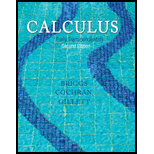
Variation of parameters Finding a particular solution when a homogeneous solution appears in the right-side function is handled using a method called variation of parameters. (This method is also used to find particular solutions of equations that cannot be handled by undetermined coefficients.) The following steps show how variation of parameters is used to find the particular solution of one specific equation.
a. Consider the equation y" – y – et. Show that the homogeneous solutions are y1 = et and y2 = e–t. Note that the right–side function is a homogeneous solution.
b. Assume a particular solution has the form
where the functions u1 and u2 are to be determined. Compute yp' and impose the condition u1'et + u2'e–t = 0 to show that ypʹ = u1et – u2′e–t.
c. Compute yp" and substitute it into the differential equation. After canceling several terms, show that the equation reduces to u1ʹet – u2ʹe–t = et.
d. Parts (c) and (d) give two equations for u1ʹ and u2ʹ Eliminate u2ʹ and show that the equation for u1 is
e. Solve the equation in part (d) for u1.
f. Use part (e) to show that the equation for u2 is
g. Solve the equation in part (f) for u2.
h. Now assemble the particular solution yp(t) =u1(t)et + u2(t)e–t and show that
Want to see the full answer?
Check out a sample textbook solution
Chapter D2 Solutions
Calculus: Early Transcendentals, 2nd Edition
- Explain the relationship between 12.3.6, (case A of 12.3.6) and 12.3.7arrow_forwardExplain the key points and reasons for the establishment of 12.3.2(integral Test)arrow_forwardUse 12.4.2 to determine whether the infinite series on the right side of equation 12.6.5, 12.6.6 and 12.6.7 converges for every real number x.arrow_forward
- use Corollary 12.6.2 and 12.6.3 to derive 12.6.4,12.6.5, 12.6.6 and 12.6.7arrow_forwardExplain the focus and reasons for establishment of 12.5.1(lim(n->infinite) and sigma of k=0 to n)arrow_forwardExplain the focus and reasons for establishment of 12.5.3 about alternating series. and explain the reason why (sigma k=1 to infinite)(-1)k+1/k = 1/1 - 1/2 + 1/3 - 1/4 + .... converges.arrow_forward
- Explain the key points and reasons for the establishment of 12.3.2(integral Test)arrow_forwardUse identity (1+x+x2+...+xn)*(1-x)=1-xn+1 to derive the result of 12.2.2. Please notice that identity doesn't work when x=1.arrow_forwardExplain the key points and reasons for the establishment of 11.3.2(integral Test)arrow_forward
- Algebra & Trigonometry with Analytic GeometryAlgebraISBN:9781133382119Author:SwokowskiPublisher:Cengage

 Glencoe Algebra 1, Student Edition, 9780079039897...AlgebraISBN:9780079039897Author:CarterPublisher:McGraw Hill
Glencoe Algebra 1, Student Edition, 9780079039897...AlgebraISBN:9780079039897Author:CarterPublisher:McGraw Hill


